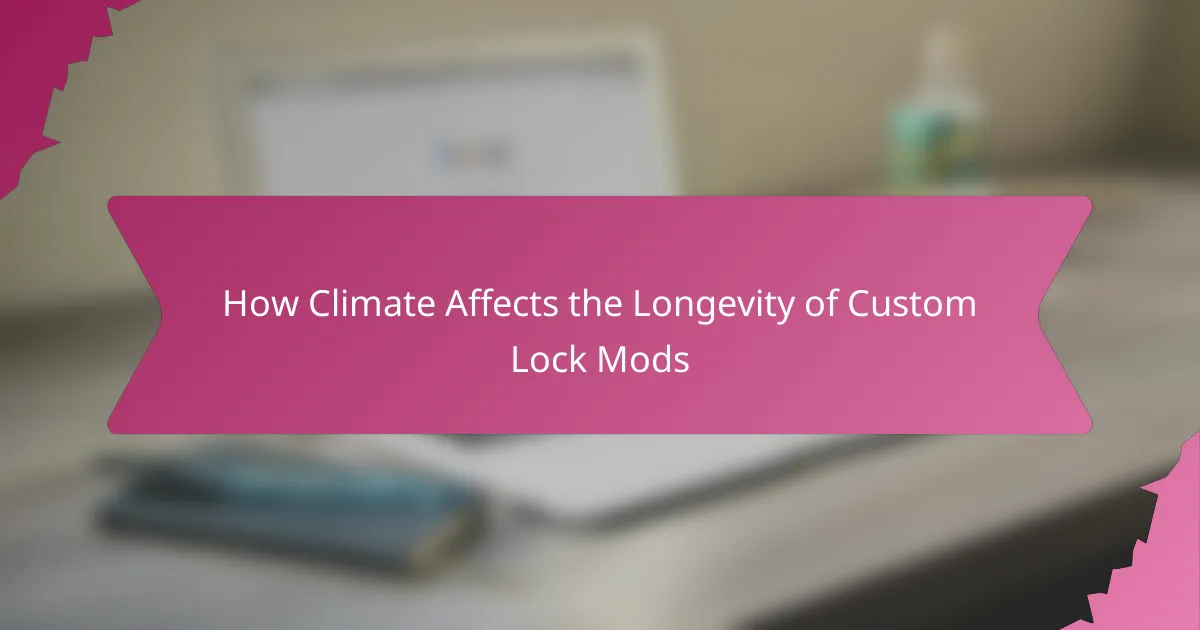Climate plays a crucial role in determining the longevity of custom lock mods, as environmental factors like temperature and humidity can lead to material wear and corrosion. Selecting appropriate materials, such as stainless steel or aluminum, is essential for ensuring durability in varying conditions. Regular maintenance and protective coatings can further safeguard these modifications against the detrimental effects of climate.

How does climate impact the durability of custom lock mods?
Climate significantly affects the durability of custom lock mods by influencing the materials used and their performance over time. Factors such as temperature and humidity can lead to wear, corrosion, and overall degradation of these modifications.
Temperature fluctuations affect material integrity
Temperature changes can cause materials in custom lock mods to expand and contract, which may lead to structural weaknesses. For example, metals can become brittle in extreme cold, while plastics may soften in high heat, affecting their fit and function.
To mitigate these effects, consider using materials specifically designed for temperature resistance, such as high-grade stainless steel or specialized polymers. Regular inspections during extreme weather conditions can help identify potential issues early.
Humidity levels influence corrosion rates
High humidity can accelerate corrosion in metal components of custom lock mods, leading to rust and reduced functionality. Environments with consistent moisture can be particularly damaging, especially if the lock mods are not treated with protective coatings.
To combat humidity-related corrosion, apply anti-corrosive sprays or use locks designed with corrosion-resistant materials. Storing lock mods in a dry place and using silica gel packs can also help maintain their integrity over time.
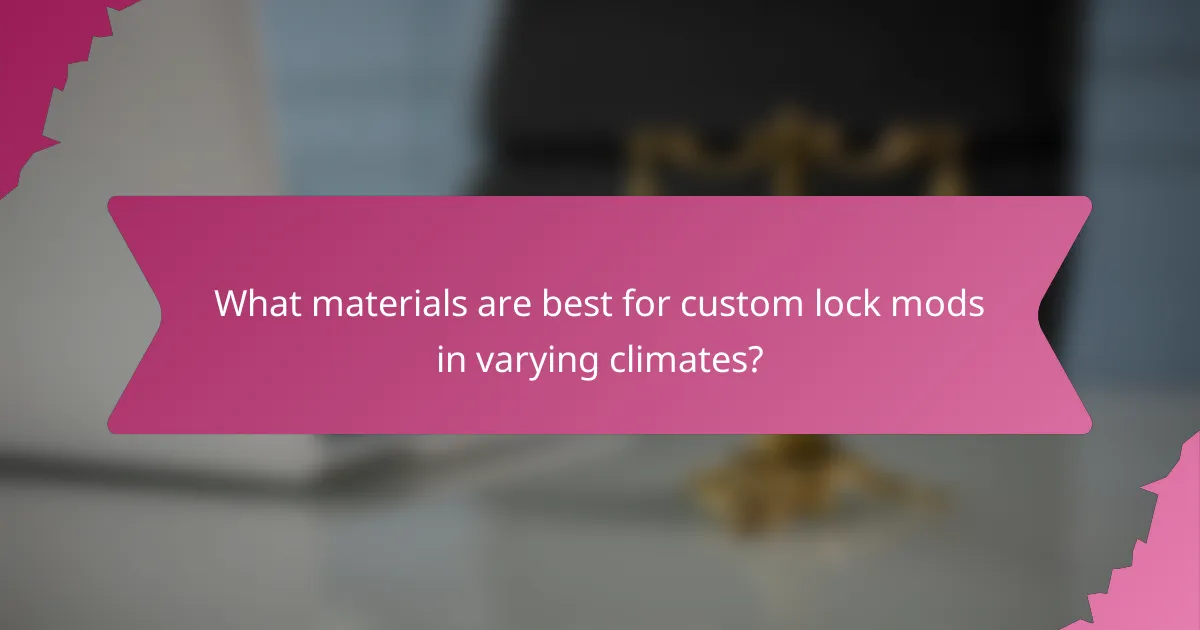
What materials are best for custom lock mods in varying climates?
Choosing the right materials for custom lock mods is crucial, as different climates can significantly impact their longevity and performance. Stainless steel and aluminum are two popular options, each suited to specific environmental conditions.
Stainless steel for humid environments
Stainless steel is ideal for humid climates due to its excellent corrosion resistance. It contains chromium, which forms a protective layer that prevents rust and degradation, making it a reliable choice for areas with high moisture levels.
When selecting stainless steel, look for grades like 304 or 316, which offer enhanced durability against environmental factors. Regular maintenance, such as cleaning and applying protective coatings, can further extend the lifespan of stainless steel lock mods in humid conditions.
Aluminum for moderate climates
Aluminum is suitable for moderate climates where temperature fluctuations are minimal. It is lightweight and resistant to corrosion, making it a practical choice for custom lock mods that require ease of handling and installation.
While aluminum can withstand some moisture, it is less durable than stainless steel in highly humid areas. Consider anodized aluminum for added protection, as this process enhances its resistance to wear and environmental damage. Regular inspections can help identify any signs of wear or corrosion early on.
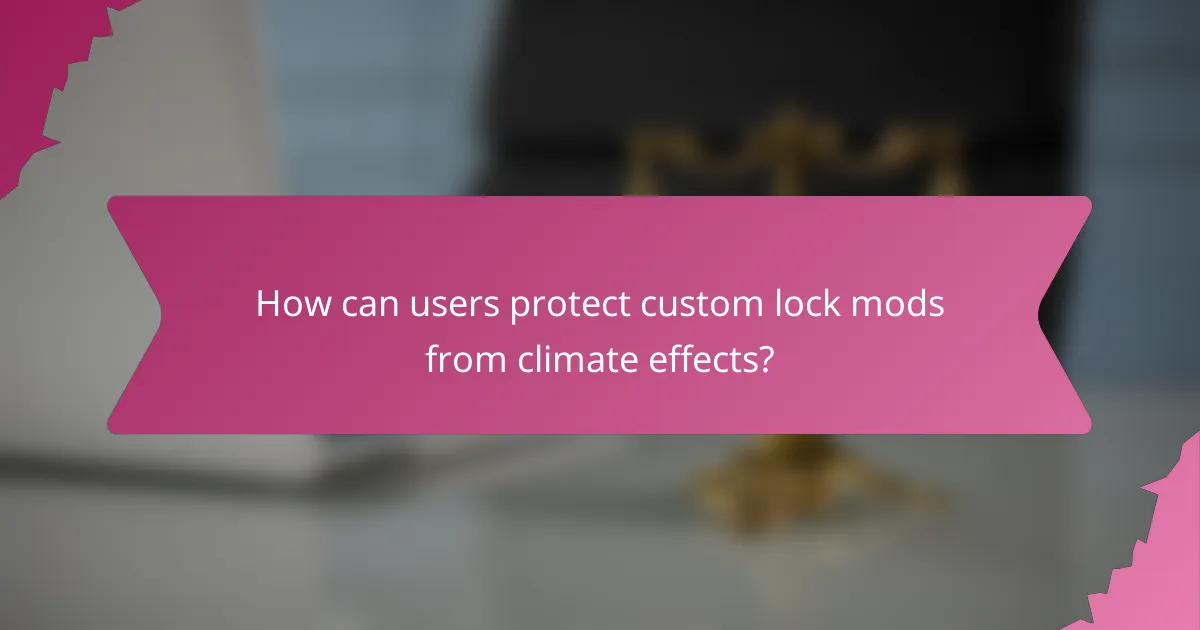
How can users protect custom lock mods from climate effects?
Users can protect custom lock mods from climate effects by implementing regular maintenance and applying protective coatings. These strategies help mitigate damage from moisture, temperature fluctuations, and other environmental factors.
Regular maintenance and lubrication
Regular maintenance is crucial for ensuring the longevity of custom lock mods. Users should inspect their locks frequently for signs of wear or corrosion, especially in humid or extreme temperature conditions.
Lubrication is a key part of maintenance. Applying a suitable lubricant, such as a silicone-based spray, can prevent rust and ensure smooth operation. Aim to lubricate the lock every few months or more often if exposed to harsh weather.
Using protective coatings
Applying protective coatings can significantly enhance the durability of custom lock mods against climate effects. Options like powder coating or specialized sealants create a barrier that shields against moisture and UV rays.
When selecting a protective coating, consider the specific climate conditions. For instance, in coastal areas with high salt content, a corrosion-resistant coating is advisable. Regularly check the integrity of the coating and reapply as needed to maintain protection.

What are the signs of climate-related wear in custom lock mods?
Climate-related wear in custom lock mods can manifest through various signs, primarily rust and corrosion on metal components, as well as cracking in plastic or rubber parts. Recognizing these indicators early can help maintain the functionality and longevity of your lock mods.
Rust and corrosion on metal components
Rust and corrosion are common issues for metal parts exposed to moisture and varying temperatures. High humidity can accelerate oxidation, leading to visible rust spots and weakened structural integrity. Regular inspection of metal components is essential to catch these signs early.
To prevent rust, consider applying a protective coating or lubricant specifically designed for metal surfaces. Storing lock mods in a dry environment can also help mitigate moisture exposure. If rust is detected, using a fine abrasive or rust remover can help restore the surface.
Cracking in plastic or rubber parts
Plastic and rubber components can become brittle and crack due to extreme temperatures and UV exposure. This deterioration can compromise the effectiveness of seals and moving parts, leading to malfunction. Regularly check for any signs of cracking, especially after exposure to harsh weather conditions.
To extend the life of these materials, store lock mods in a climate-controlled environment and avoid direct sunlight when possible. If cracks are found, replacing the affected parts promptly can prevent further damage and ensure optimal performance.
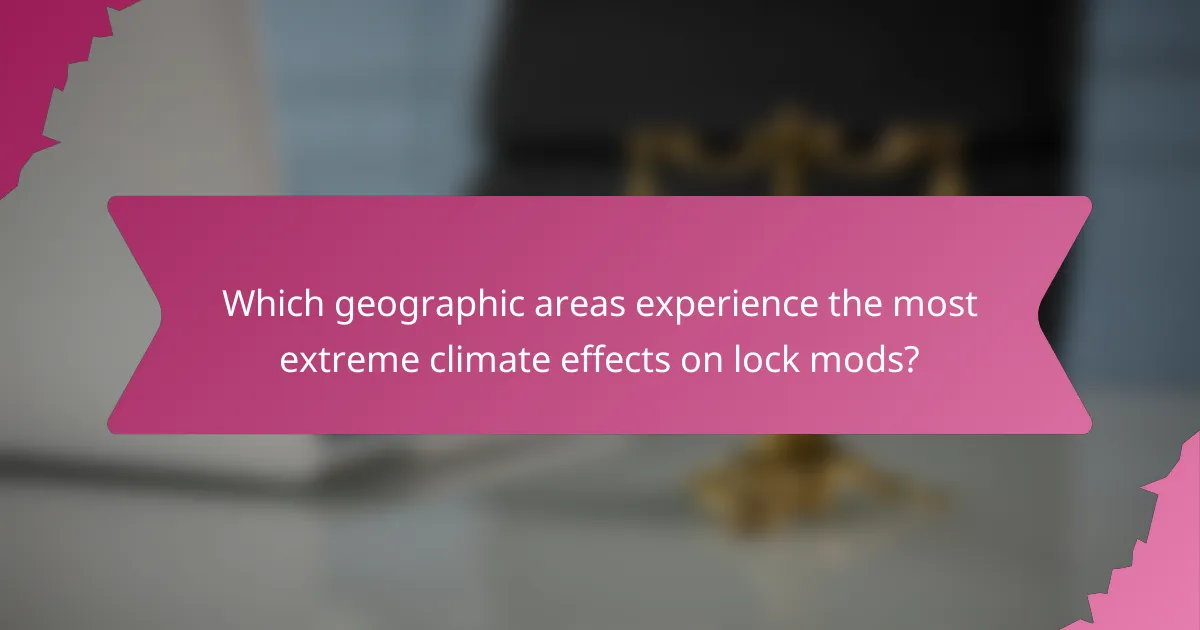
Which geographic areas experience the most extreme climate effects on lock mods?
Coastal regions and desert areas are among the geographic locations that experience the most extreme climate effects on custom lock mods. High humidity and drastic temperature fluctuations can significantly impact the longevity and functionality of these modifications.
Coastal regions with high humidity
In coastal areas, high humidity can lead to corrosion and rust on metal components of lock mods. The constant exposure to moisture can degrade the materials, causing them to wear out faster than in drier climates.
To mitigate these effects, consider using lock mods made from corrosion-resistant materials such as stainless steel or brass. Regular maintenance, including cleaning and applying protective coatings, can also extend the lifespan of locks in humid environments.
Desert areas with extreme temperature changes
Desert regions experience significant temperature fluctuations between day and night, which can cause materials in lock mods to expand and contract. This thermal cycling can lead to mechanical failure or misalignment over time.
To counteract these issues, choose lock mods designed to withstand extreme temperatures. Regular inspections and adjustments can help ensure that locks remain functional despite the harsh conditions.
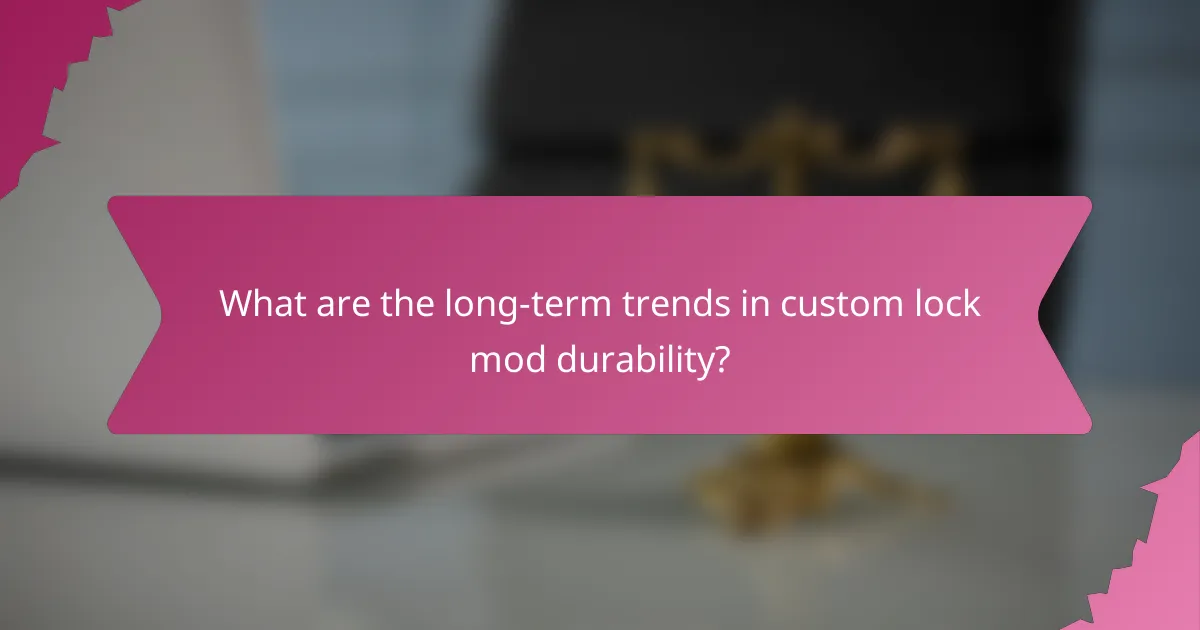
What are the long-term trends in custom lock mod durability?
Long-term trends in custom lock mod durability indicate that advancements in materials and design are significantly enhancing their lifespan. As manufacturers adapt to environmental challenges, the durability of these mods is increasingly influenced by climate factors.
Increasing use of advanced materials
Manufacturers are increasingly utilizing advanced materials such as high-grade plastics, stainless steel, and specialized coatings to improve the durability of custom lock mods. These materials are designed to resist corrosion, wear, and temperature fluctuations, which are critical for longevity in various climates.
For example, mods made with aircraft-grade aluminum or titanium tend to offer superior strength and resistance to environmental stressors compared to standard materials. This shift not only enhances durability but also reduces the overall weight of the mods, making them more user-friendly.
Development of climate-resistant designs
Climate-resistant designs are becoming essential in the production of custom lock mods. Features such as sealed components, moisture-resistant finishes, and thermal insulation help protect the internal mechanisms from humidity, temperature extremes, and dust.
For instance, mods designed for use in humid environments often incorporate gaskets and seals to prevent moisture ingress, while those intended for colder climates may include materials that maintain functionality at lower temperatures. These design innovations are crucial for ensuring that custom lock mods remain reliable over time, regardless of the conditions they face.
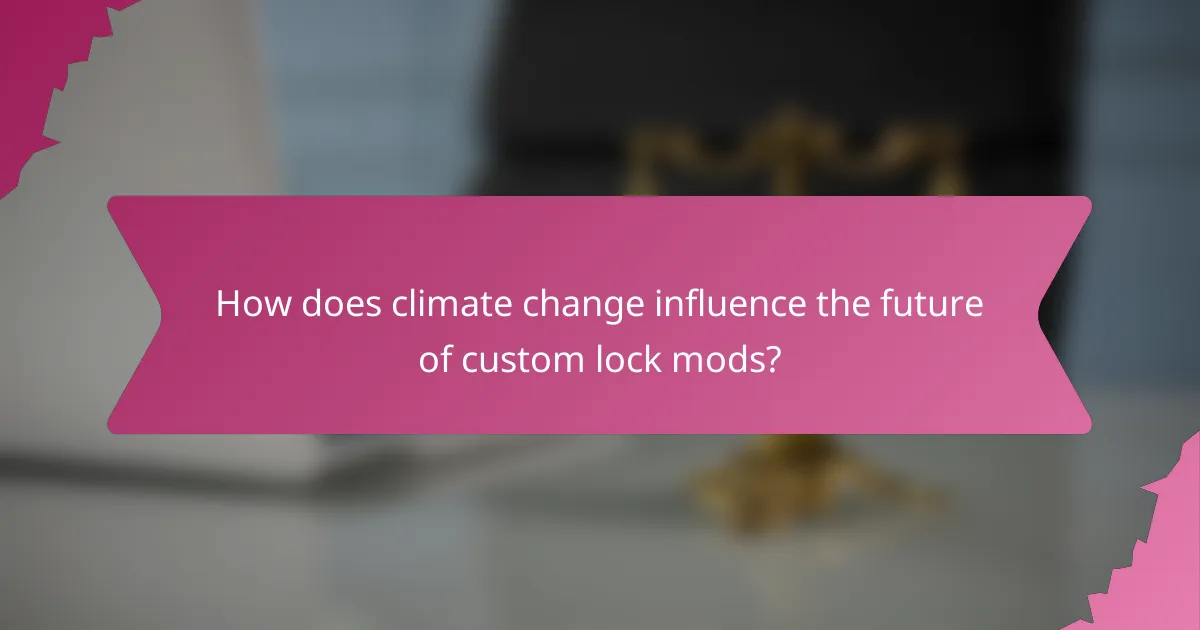
How does climate change influence the future of custom lock mods?
Climate change significantly affects the longevity of custom lock mods by altering environmental conditions that can lead to material degradation and mechanical failure. Increased temperatures, humidity, and extreme weather events necessitate adaptations in design and materials to ensure reliability and durability.
Adaptation to more extreme weather patterns
Custom lock mods must be designed to withstand more extreme weather patterns, such as heavy rainfall, intense heat, and freezing temperatures. These conditions can cause corrosion, swelling, or brittleness in materials traditionally used in lock mods.
For instance, using stainless steel or weather-resistant coatings can enhance the longevity of locks exposed to harsh climates. Additionally, implementing seals and gaskets can help prevent moisture ingress, which is crucial in areas prone to flooding or high humidity.
Emerging technologies for enhanced durability
Advancements in material science are leading to the development of new composites and treatments that improve the durability of custom lock mods. For example, thermoplastic elastomers and advanced polymers can provide better resistance to temperature fluctuations and environmental stressors.
Furthermore, 3D printing technology allows for the creation of custom parts with complex geometries that can enhance strength while reducing weight. As these technologies evolve, they offer opportunities for manufacturers to produce lock mods that are not only more resilient but also tailored to specific climate challenges.
